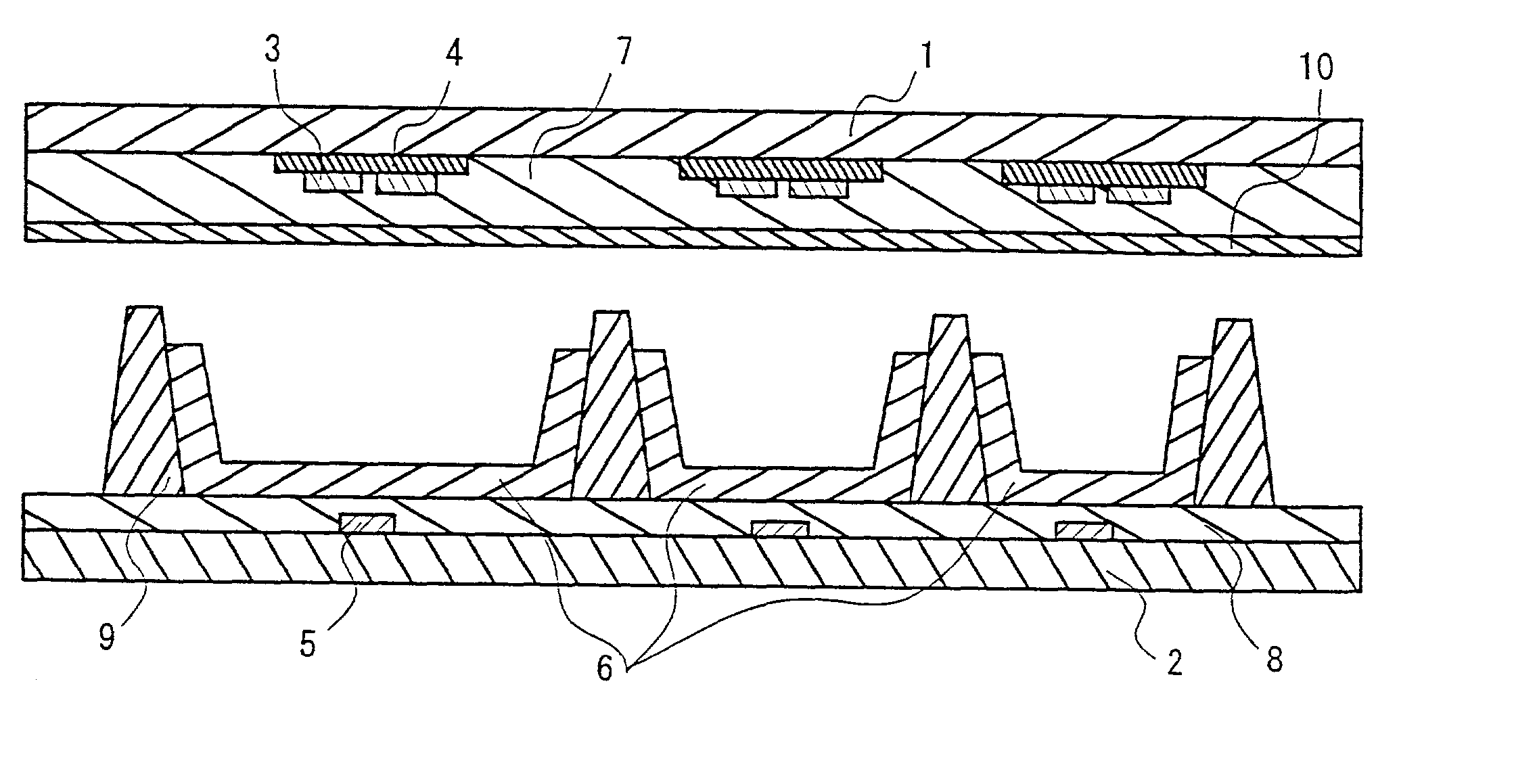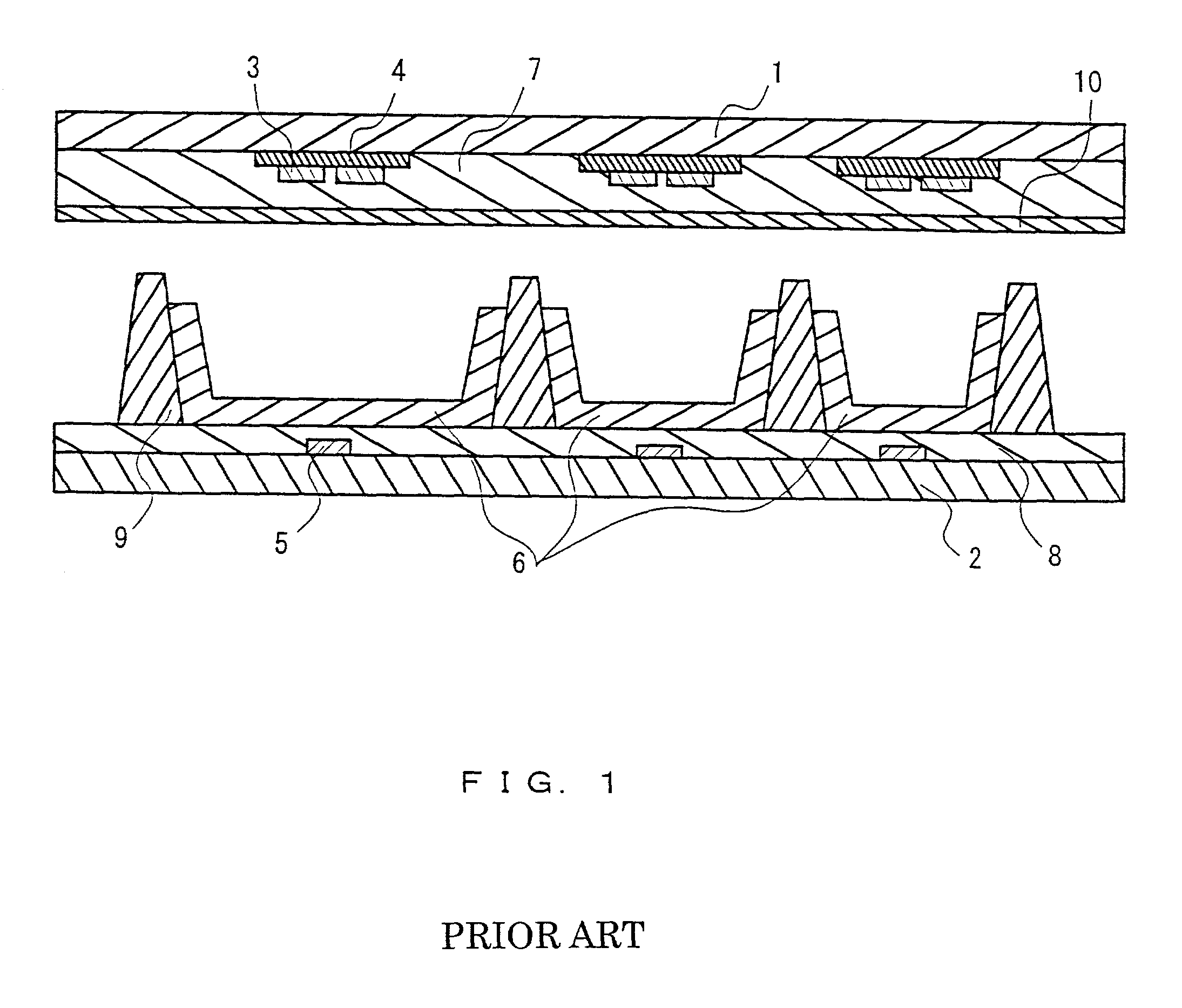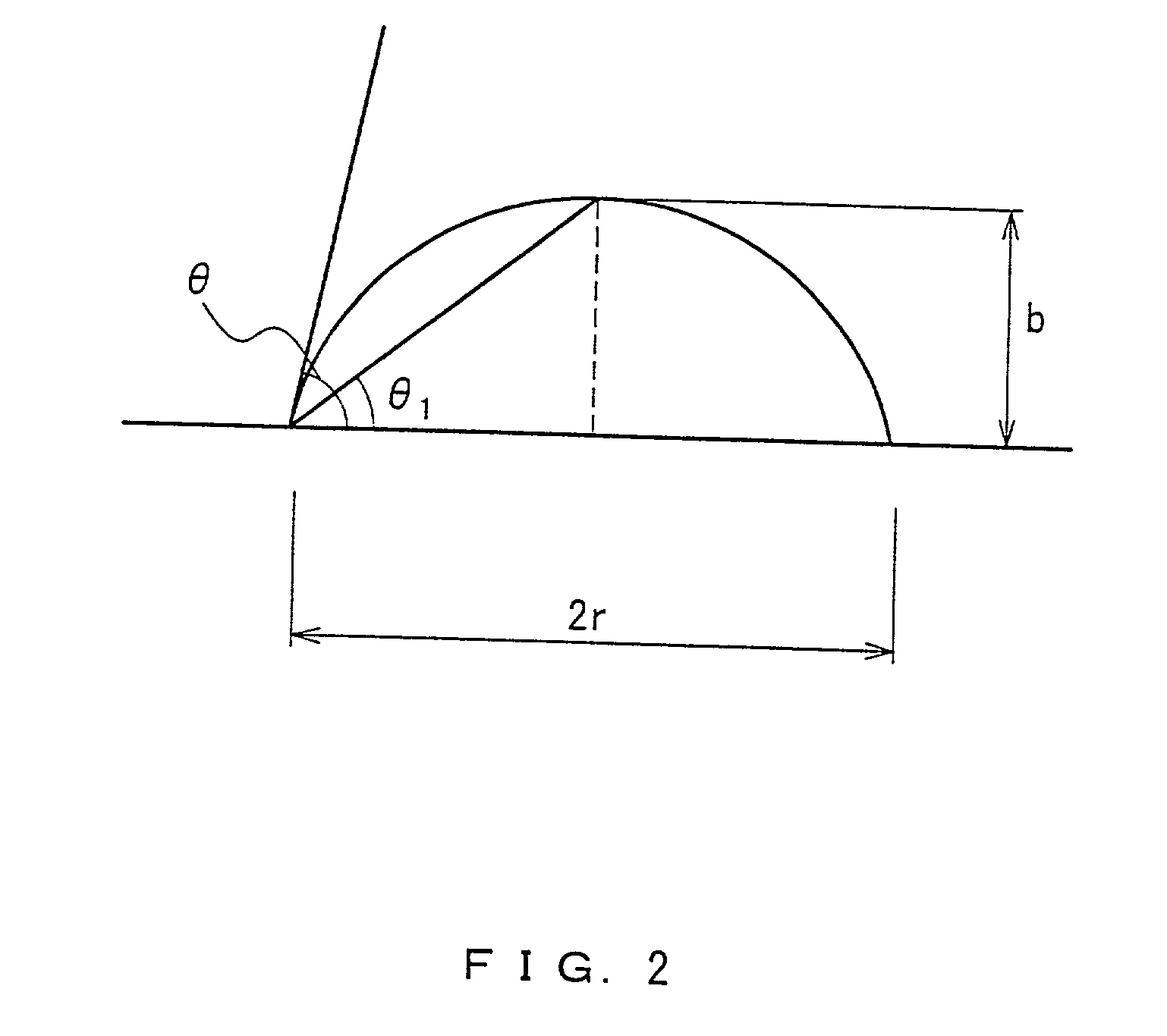Paint for forming insulating film, and plasma display panel using the paint and method of manufacturing the same
a technology of insulating film and paint, which is applied in the manufacture of electrode systems, electric discharge tubes/lamps, transportation and packaging, etc., can solve the problems of increased manufacturing costs, increased production costs, and increased difficulty in increasing an area, so as to improve the flowability of paint, reduce the cost, and improve the effect of wettability
Inactive Publication Date: 2002-05-30
PANASONIC CORP
View PDF0 Cites 9 Cited by
- Summary
- Abstract
- Description
- Claims
- Application Information
AI Technical Summary
Benefits of technology
[0052] Further, the solvent (c) further may contain a solvent other than the above-mentioned seven solvents as long as the resultant mixed solvent can produce the effect of the invention. Examples of the solvent that can be mixed with the above-mentioned seven solvents include terpenes such as .alpha.-, .beta.-, and .gamma.-terpineols; ethylene glycol monoalkyl ethers; ethylene glycol dialkyl ethers; diethylene glycol monoalkyl ethers; diethylene glycol dialkyl ethers; ethylene glycol monoalkyl ether acetates; ethylene glycol dialkyl ether acetates; diethylene glycol monoalkyl ether acetates; diethylene glycol dialkyl ether acetates; propylene glycol monoalkyl ethers; propylene glycol dialkyl ethers; propylene glycol monoalkyl ether acetates; propylene glycol dialkyl ether acetates; dipropylene glycol monoalkyl ethers; dipropylene glycol dialkyl ethers; dipropylene glycol monoalkyl ether acetates; dipropylene glycol dialkyl ether acetates; tripropylene glycol monoalkyl ethers; tripropylene glycol dialkyl ethers; tripropylene glycol trialkyl ethers; tripropylene glycol monoalkyl ether acetates; tripropylene glycol dialkyl ether acetates; tripropylene glycol trialkyl ether acetates; and alcohols such as methanol, ethanol, isopropanol, and 1-butanol. These solvents may be used alone or in combination of two or more types.
[0053] Among these, it is preferable to use as the solvent (c) at least two solvents selected from diethyl carbitol, dipropylene glycol-n- propyl ether, tripropylene glycol monomethyl ether, and diethyl cellosolve. The reason for this is that these four solvents have a good wettability to glass, ceramic, and a metal compound regardless of whether ultraviolet cleaning is performed or not. In addition, these four solvents can be prepared at low cost. Further, these four solvents differ in boiling points by at least 10.degree. C. (diethyl cellosolve has the lowest boiling point of 121.degree. C. and tripropylene glycol monomethyl ether has the highest boiling point of 242.degree. C.), and also differ in drying rates. Therefore, by using at least two of these solvents in combination, the solvent component is prevented from being abruptly volatilized from the paint film during drying. As a result, the generation of voids and / or pin-holes inside the dried paint film is suppressed and the surface of the dried paint film is prevented from being rough.
[0054] When preparing the paint for forming an insulating film according to the present invention, the proportion of the solvent (c) in the paint preferably is 4 to 85 wt. %, more preferably 5 to 60 wt. %, and most preferably 10 to 40 wt. %. When the paint contains less than 4 wt. % of the solvent (c), the flowability of the paint is made lower to degrade the ease of coating. On the other hand, when the paint contains more than 85 wt. % of the solvent (c), the paint film shrinks greatly during drying, which may leads to the occurrence of defects and also to high cost.
[0055] The inorganic fine particles (a) as an inorganic component contained in the paint for forming an insulating film according to the present invention are not specifically limited. Any known inorganic compounds capable of forming an insulating film can be used as the inorganic fine particles (a). Among these, metal oxides preferably are used. In particular, metal oxides such as SiO.sub.2, ZnO, B.sub.2O.sub.3, PbO, Bi.sub.2O.sub.3, BaO, P.sub.2O.sub.5, CaO, SrO, and MgO are preferable. Low melting point glass generally used as an insulating film is formed using glass powder containing at least two of these oxides. In particular, glass powder containing PbO as a main component preferably is used because of its ease of control, e.g., ease of softening-point adjustment. Therefore, by adding the above fine particles to the paint for forming an insulating film, insulation performance of the paint can be improved. These inorganic fine particles may be used alone or in combination.
[0056] The inorganic fine particles (a) preferably have an average particle diameter of 0.1 to 10 .mu.m, more preferably 0.3 to 7 .mu.m, and most preferably 0.5 to 5 .mu.m. When the inorganic fine particles (a) have an average particle diameter of less than 0.1 .mu.m, the fine particles have high cohesion and the paint film is likely to have defects. On the other hand, when the inorganic fine particles (a) have an average particle diameter of more than 10 .mu.m, the filling rate of the fine particles inside the paint film is made lower and the paint film is likely to have defects.
[0057] When preparing the paint for forming an insulating film according to the present invention, the proportion of the inorganic fine particles (a) in the paint preferably is 10 to 95 wt. %, more preferably 40 to 90 wt. %, and most preferably 60 to 80 wt. %. When the paint contains less than 10 wt. % of the inorganic fine particles (a), the paint film suffers a great loss during drying and firing, resulting in high cost. On the other hand, when the paint contains more than 95 wt. % of the inorganic fine particles (a), the flowability of the paint is reduced and affects the ease of coating.
Problems solved by technology
However, LCDs have problems such that images obtained are dark, a viewing angle is narrow, and it is difficult to increase an area thereof.
However, the methods utilizing a vacuum such as vacuum evaporation and spattering require costly production facilities.
Especially in the case of manufacturing FPD, which seeks an increased area as described above, the manufacturing costs become even higher.
However, when an insulating film is formed by the coating method, voids and / or pin-holes are generated in the resultant insulating film unless characteristics of the paint used for forming the film has been optimized.
Thus, according to the coating method, it is difficult to obtain an insulating film producing a desired insulating effect.
Other than this, the insufficient wettability of the solvent contained in the paint is considered to be the major cause of the generation of the voids and / or pin-holes.
If the solvent has a poor wettability to the surface to be coated with the paint, crawling occurs, which accompanies the generation of cavities.
Crawling is the phenomenon in which the paint is not spread evenly on the surface so that uncoated portions result.
Therefore, the resultant insulating film is formed unevenly and a desired insulating effect thus cannot be obtained.
Further, when the surface to be coated with the paint has roughness, the chances of crawling occurring and the generation of cavities increase.
As a result, the resultant insulating film is formed still more unevenly so that some portions of the film have a thickness smaller than the other portions of the film.
A desired insulating effect thus cannot be obtained.
However, these solvents do not have a good wettability to glass and thus causes crawling of the paint, which accompanies the generation of voids and / or pin-holes in the resultant film, separation of the film, etc.
However, no attempt has been made to control the wettability of the paints by adjusting the composition of the solvent as a dispersion medium necessary to form the paints.
In the case where the paint for forming an insulating film has a poor wettability to the surface to be coated with the paint, crawling occurs between the paint and the surface coated with the paint, which leads to the generation of voids and / or pin-holes in the paint film and to the separation of the paint film due to the insufficient adhesion between the paint and the surface.
When the solvent forms a contact angle of 5.degree. or more with glass and ceramic, the paint has a poor wettability to the back dielectric layer, which is a surface to be coated with the paint.
This may lead to the problems such that the resultant partition walls collapse due to the voids generated inside the partition walls and the paint film is etched unevenly by sandblasting.
When the solvent forms a contact angle of 5.degree. or more with glass, a metal compound, and ceramic, the paint has a poor wettability to the glass substrate and the electrodes, and voids and / or cavities are generated in the paint film due to the incorporation of air bubbles at the time of coating.
% of the solvent (c), the paint film shrinks greatly during drying, which may leads to the occurrence of defects and also to high cost.
When the inorganic fine particles (a) have an average particle diameter of less than 0.1 .mu.m, the fine particles have high cohesion and the paint film is likely to have defects.
On the other hand, when the inorganic fine particles (a) have an average particle diameter of more than 10 .mu.m, the filling rate of the fine particles inside the paint film is made lower and the paint film is likely to have defects.
% of the inorganic fine particles (a), the paint film suffers a great loss during drying and firing, resulting in high cost.
% of the binder resin, the paint film (dry film) cannot preserve its form and thus loses its shape.
% of the binder resin, the paint film suffers a great loss during firing, and the paint film becomes more likely to have defects.
Method used
the structure of the environmentally friendly knitted fabric provided by the present invention; figure 2 Flow chart of the yarn wrapping machine for environmentally friendly knitted fabrics and storage devices; image 3 Is the parameter map of the yarn covering machine
View moreImage
Smart Image Click on the blue labels to locate them in the text.
Smart ImageViewing Examples
Examples
Experimental program
Comparison scheme
Effect test
example 1
arbitol (diethylene glycol dithyl ether)
example 4
ellosolve (ethylene glycol diethyl ether)
the structure of the environmentally friendly knitted fabric provided by the present invention; figure 2 Flow chart of the yarn wrapping machine for environmentally friendly knitted fabrics and storage devices; image 3 Is the parameter map of the yarn covering machine
Login to View More PUM
| Property | Measurement | Unit |
|---|---|---|
| contact angle | aaaaa | aaaaa |
| wt. % | aaaaa | aaaaa |
| particle diameter | aaaaa | aaaaa |
Login to View More
Abstract
The present invention provides a paint for forming an insulating film, which has a good wettability to a surface to be coated with the paint and has no voids or pin-holes after being fired; a plasma display panel including a dielectric layer formed using the paint; and a method of manufacturing the plasma display panel. The paint contains inorganic fine particles, a binder resin, and an organic solvent that has a good wettability to glass such as a glass substrate, ceramic as an Ag electrode, and a metal compound such as an ITO film and forms a contact angle of less than 5° with these inorganic materials. Accordingly, the paint has a good wettability to a glass substrate, an Ag electrode, and an ITO film and the resultant insulating film thus has no voids or pin-holes.
Description
[0001] 1. Field of the Invention[0002] The present invention relates to a paint for forming an insulating film used in a plasma display panel, a plasma address liquid crystal display, or an image forming apparatus using electron-emitting elements, and to a plasma display panel in which an address electrode protective film and partition walls provided on its back plate and a dielectric layer provided on its front plate are formed using this paint. It is to be noted that the term "paint" used in this application means a liquid composition using a volatile carrier and coating components in which the coating components are left behind on a surface after the evaporation of the carrier.[0003] 2. Description of the Related Art[0004] As an image forming apparatus that can be substituted for a heavy and large conventional cathode-ray tube, there has been increasing demand for a thin and light flat-type display or, as it is called, a flat panel display (FPD). A typical FPD is a liquid crystal...
Claims
the structure of the environmentally friendly knitted fabric provided by the present invention; figure 2 Flow chart of the yarn wrapping machine for environmentally friendly knitted fabrics and storage devices; image 3 Is the parameter map of the yarn covering machine
Login to View More Application Information
Patent Timeline
 Login to View More
Login to View More Patent Type & Authority Applications(United States)
IPC IPC(8): C09D5/25H01J11/12H01J11/36H01J11/38
CPCC03C17/007C03C2217/445C03C2217/475H01J2211/366H01J11/36H01J11/38H01J11/12Y10T428/31786
Inventor HAYASHI, TOMOHIROMIFUNE, TATSUO
Owner PANASONIC CORP
Features
- R&D
- Intellectual Property
- Life Sciences
- Materials
- Tech Scout
Why Patsnap Eureka
- Unparalleled Data Quality
- Higher Quality Content
- 60% Fewer Hallucinations
Social media
Patsnap Eureka Blog
Learn More Browse by: Latest US Patents, China's latest patents, Technical Efficacy Thesaurus, Application Domain, Technology Topic, Popular Technical Reports.
© 2025 PatSnap. All rights reserved.Legal|Privacy policy|Modern Slavery Act Transparency Statement|Sitemap|About US| Contact US: help@patsnap.com



